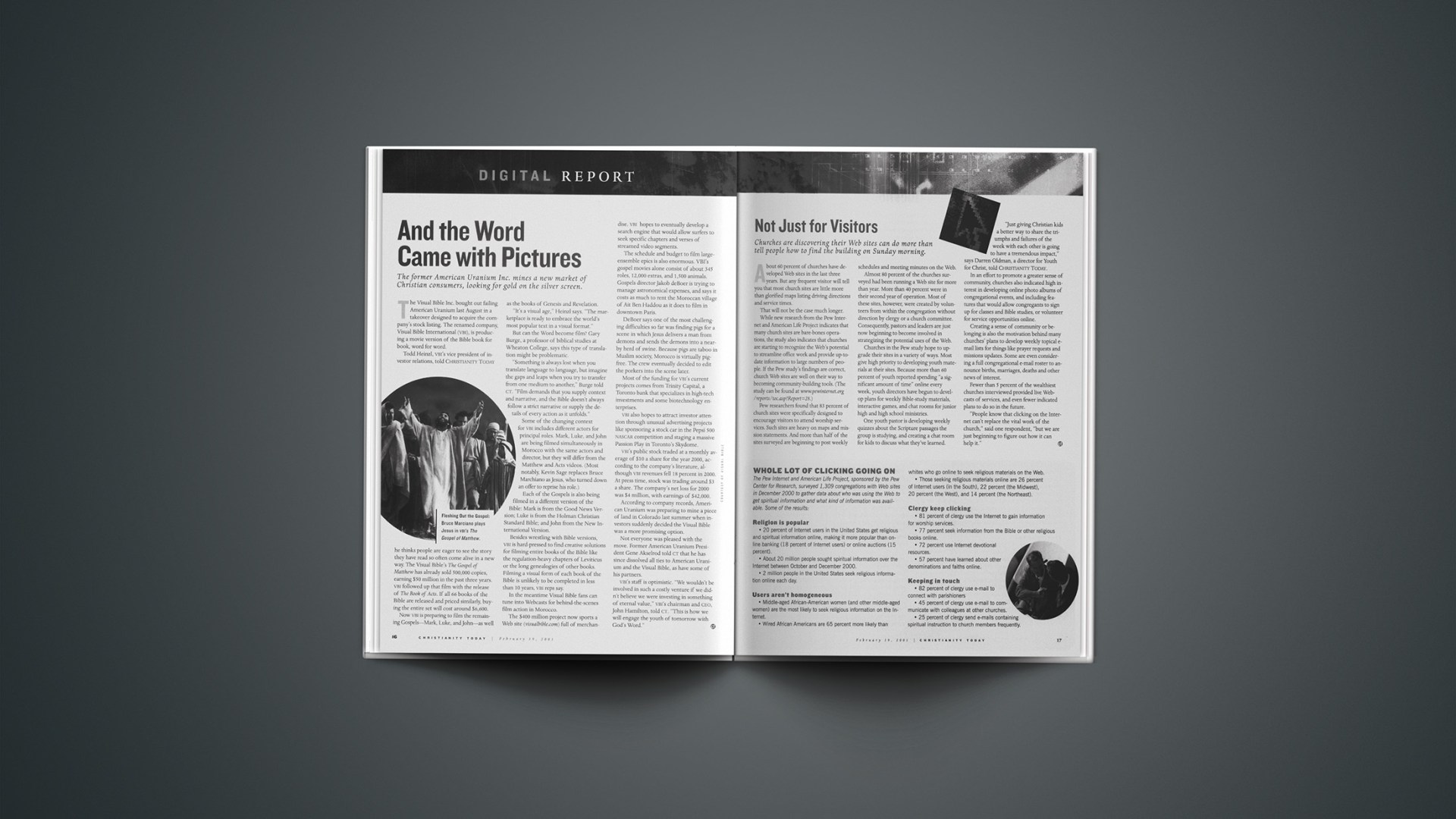That will not be the case much longer.
While new research from the Pew Internet and American Life Project indicates that many church sites are bare-bones operations, the study also indicates that churches are starting to recognize the Web’s potential to streamline office work and provide up-to-date information to large numbers of people. If the Pew study’s findings are correct, church Web sites are well on their way to becoming community-building tools. (The study can be found at www.pewinternet.org/reports/toc.asp?Report=28.)
Pew researchers found that 83 percent of church sites were specifically designed to encourage visitors to attend worship services. Such sites are heavy on maps and mission statements. And more than half of the sites surveyed are beginning to post weekly schedules and meeting minutes on the Web.
Almost 80 percent of the churches surveyed had been running a Web site for more than year. More than 40 percent were in their second year of operation. Most of these sites, however, were created by volunteers from within the congregation without direction by clergy or a church committee. Consequently, pastors and leaders are just now beginning to become involved in strategizing the potential uses of the Web.
Churches in the Pew study hope to upgrade their sites in a variety of ways. Most give high priority to developing youth materials at their sites. Because more than 60 percent of youth reported spending “a significant amount of time” online every week, youth directors have begun to develop plans for weekly Bible-study materials, interactive games, and chat rooms for junior high and high school ministries.
One youth pastor is developing weekly quizzes about the Scripture passages the group is studying, and creating a chat room for kids to discuss what they’ve learned.
“Just giving Christian kids a better way to share the triumphs and failures of the week with each other is going to have a tremendous impact,” says Darren Oldman, a director for Youth for Christ, told Christianity Today.
In an effort to promote a greater sense of community, churches also indicated high interest in developing online photo albums of congregational events, and including features that would allow congregants to sign up for classes and Bible studies, or volunteer for service opportunities online.
Creating a sense of community or belonging is also the motivation behind many churches’ plans to develop weekly topical e-mail lists for things like prayer requests and missions updates. Some are even considering a full congregational e-mail roster to announce births, marriages, deaths and other news of interest.
Fewer than 5 percent of the wealthiest churches interviewed provided live Webcasts of services, and even fewer indicated plans to do so in the future.
“People know that clicking on the Internet can’t replace the vital work of the church,” said one respondent, “but we are just beginning to figure out how it can help it.”
Copyright © 2001 Christianity Today. Click for reprint information.
Related Elsewhere
See today’s related article: “Whole Lot of Clicking Going On | Some results of the Pew Internet and American Life Project.”Pew’s findings that 20 percent of Internet users in the U.S. get religious information online helped its study “Wired Churches, Wired Temples: Taking congregations and missions into cyberspace” make a big splash.
The Pew Internet and American Life Project researches everything from the number of users online to the backgrounds, preferences, and online habits of people who use the Web the most. Some recent studies have focused on: Tracking Online Life, ‘Freeloading’ Music on the Internet, Who’s Not Online, Trust and Privacy Online, and The Online Health Care Revolution.
Some churches are so convinced that the Web is the way to grow that they are pouring a great deal of resources into their sites, like Fellowshipchurch.com near Dallas, Texas. The church officially changed its name in January to include the dot com, hired a “technology pastor”, and has developed a church site with movie reviews, stock quotes, and free customized e-mail.
Other media coverage of Pew’s wired churches study includes:
Church presence on Net growing, study finds — The Washington Post (Jan. 6, 2001)
‘Wired churches, wired temples’ — The Christian Science Monitor (Jan. 4, 2001)
Congregations Put Their Faith in the Net — The New York Times (Dec. 28, 2000)
Blacks post Net gains — USA Today (Oct. 23, 2000)
Churches Use Net to Reach the Faithful — The Washington Post (April 10, 1999)
Previous Christianity Today articles about churches using the Internet include:
And Now, a Web Site to Help You Reflect on Your Sins | U.K. Christian radio station’s ‘reflective’ site already a hit. (Feb. 2, 2000)
Onward, Christian Surfers! | The Church of England gives marching orders to Christians on the Web. (Nov. 23, 1999)
Church of the Web | More ministries fund Internet evangelism.(June 14, 1999)










